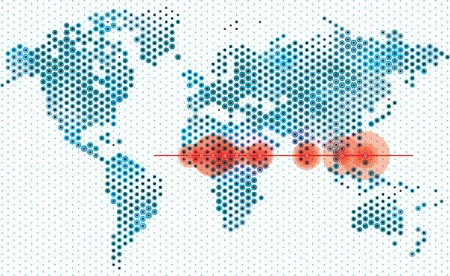
Tenth parallel as portrayed in NYT book review (illustration by Carl DeTorres)
Good book on the observation of a religious fault line between the predominantly Muslim north and the predominantly Christian/other south of Africa:
“Dispatches From the Fault Line Between Christianity and Islam” by Eliza Griswold.
Find the book here on Amazon.
Find the NYT review here.
And to clarify: the map I presented draws a line between a north where Muslims predominate and a south where Christians/animists predominate. The line is where the two realities bump up against one another (shifting from one majority – on average – to the other), but no, that doesn’t mean there are no Muslims in the south nor does it mean there are no Christians in the north. But if you track conflict in Africa, you do find a lot of civil strife concentrates itself along this line. Causality is always complex, but when the fighting starts, identities come immediately into play – a dynamic we see the world over.
Good example, my two adopted Ethiopian daughters (who are sisters) hail from a Pentecostal farming clan right along the line (just above north Kenyan border and sandwiched between Somalia and Uganda), where most farmers are Muslims but the Christians are making inroads at a rapid pace due to evangelical ministries (to our great surprise when we spent time with her, their birth mother was deeply relieved to hear we were Christians, because she made it pretty clear that was a huge part of her identity even as we tend to be far more relaxed about such things). You look at any point in the history of modern globalization’s spread (and here I’m talking about the US-inspired and -engineered post-WWII version) and you will consistently find that religion burns hottest along the frontier. It was true as the United States grew westward across the 19th century, and it’s true today as globalization continues expanding.
Right now, southern Ethiopia (at least where I’ve spent time) strikes me as a wonderfully peaceful place, but there’s al-Shabaab to the east, the historically recent incidences of widespread civil strife to the south (Kenya), and the ongoing drought/rising famine that extends across the Horn in that area. Then there’s a functioning and increasingly busy highway that runs from Addis – right through this previously fairly isolated region – and progressively extends itself to Nairobi (I am told, as I didn’t travel that far south last year). As traffic continues to boom along this highway (truly something to witness), that transactional critical mass and connectivity changes EVERYTHING in the area by mixing things up a whole lot more. All that churn creates tensions, and when those tensions get out of hand , people self-divide themselves typically along various vectors, with religion being a key one. Will it happen there? Based on my travels in southern Ethiopia last year and some reporting I did from north Kenya back in 2007, I remain optimistic enough. But the record of civil strife along this line is hard to deny.
People can definitely read a lot into that observation, and I am most definitely guilty of not writing the 4,000-word post to explain every detail and caveat every point (that’s what my 500,000-word trilogy of books was for), but I’ll stop there, because “memitchell” does a good job of explaining my larger logic in the discussion thread from the earlier post (as in, anyone familiar with my writing knows I do not demonize the Chinese -and not just because I have an adopted child from there too, as more than a few critics have alleged). Putting aside all the usual ad hominen attacks, let me say that, having briefed my stuff all over Africa the past decade, I find people there to be highly realistic about the promises and perils of the rapid globalization of the continent. To me, Africa is ground zero for rising globalization connectivity right now. That means lots of good things but the same bad things we’ve seen when connectivity has ramped up elsewhere previously, and nothing gets more challenged than group identities.


